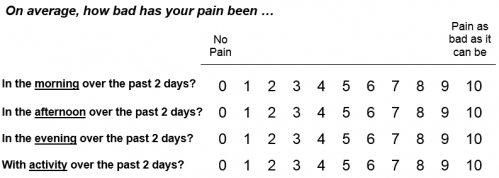4-Item Pain Intensity Measure (P4): Difference between revisions
mNo edit summary |
Evan Thomas (talk | contribs) mNo edit summary |
||
| Line 1: | Line 1: | ||
<div class="editorbox"> | <div class="editorbox"> | ||
'''Original Editor '''- [[User:Evan Thomas|Evan Thomas]] | '''Original Editor ''' - [[User:Evan Thomas|Evan Thomas]] | ||
'''Top Contributors''' - {{Special:Contributors/{{FULLPAGENAME}}}} | '''Top Contributors''' - {{Special:Contributors/{{FULLPAGENAME}}}} | ||
| Line 8: | Line 8: | ||
The P4 consists of 4 items that address pain intensity in the morning, afternoon, evening, and with activity over the past 2 days. Each item is scored on a 0-to-10 NPRS, therefore the total P4 scores can vary from 0 (no pain) to 40 (the highest possible pain level). Most patients can complete the P4 in less than a minute and clinicians can score the measure in 5 seconds without the use of computational aids.<ref name="Spadoni 2004">Spadoni GF, Stratford PW, Solomon PE, Wishart LR. The Evaluation of Change in Pain Intensity: A Comparison of the P4 and Single-Item Numeric Pain Rating Scales. J Orthop Sports Phys Ther, 2004: 34(4): 187-93.</ref> | The P4 consists of 4 items that address pain intensity in the morning, afternoon, evening, and with activity over the past 2 days. Each item is scored on a 0-to-10 NPRS, therefore the total P4 scores can vary from 0 (no pain) to 40 (the highest possible pain level). Most patients can complete the P4 in less than a minute and clinicians can score the measure in 5 seconds without the use of computational aids.<ref name="Spadoni 2004">Spadoni GF, Stratford PW, Solomon PE, Wishart LR. The Evaluation of Change in Pain Intensity: A Comparison of the P4 and Single-Item Numeric Pain Rating Scales. J Orthop Sports Phys Ther, 2004: 34(4): 187-93.</ref> | ||
The purpose of developing this questionnaire was to attempt assessing change better than the two | The purpose of developing this questionnaire was to attempt assessing change better than the two different versions of a single-item NPRS.<ref name="Spadoni 2004" /> | ||
= Intended Population = | = Intended Population = | ||
| Line 36: | Line 36: | ||
MDC<sub>90</sub> = 9.1 points or 22.2% of the scale range<ref name="Spadoni 2004" /> | MDC<sub>90</sub> = 9.1 points or 22.2% of the scale range<ref name="Spadoni 2004" /> | ||
== References == | == References == | ||
<references /> | <references /> | ||
[[Category: | [[Category:Outcome_Measures]] [[Category:Pain]] [[Category:Assessment]] | ||
Revision as of 20:28, 28 October 2017
Original Editor - Evan Thomas
Top Contributors - Evan Thomas, Andeela Hafeez, WikiSysop and Melissa Coetsee
Summary[edit | edit source]
The P4 consists of 4 items that address pain intensity in the morning, afternoon, evening, and with activity over the past 2 days. Each item is scored on a 0-to-10 NPRS, therefore the total P4 scores can vary from 0 (no pain) to 40 (the highest possible pain level). Most patients can complete the P4 in less than a minute and clinicians can score the measure in 5 seconds without the use of computational aids.[1]
The purpose of developing this questionnaire was to attempt assessing change better than the two different versions of a single-item NPRS.[1]
Intended Population[edit | edit source]
Those over the age of 16 with non-chronic musculoskeletal pain.[1] It has also been shown to be valid when used in conjunction with the WOMAC in people with osteoarthritis awaiting total knee or total hip replacements.[2]
Method of Use[edit | edit source]
Patients are asked to circle a single number that corresponds to their pain at each time of day and with activity over the previous 2 days. The numbers are then totaled to yield a score out of 40.
Evidence[edit | edit source]
Reliability[edit | edit source]
Test-retest reliability = 0.78[1]
Validity[edit | edit source]
Longitudinal validity = 0.63 and 0.57 between the retrospective rating of change and the P4 and 24-hour NPRS (z = 1.73, P1 = .043), and 0.61 and 0.56 between the retrospective rating of change and the P4 and 2-day NPRS (z = 2.53, P1 = .006), respectively.[1]
Responsiveness[edit | edit source]
MDC90 = 9.1 points or 22.2% of the scale range[1]
References[edit | edit source]
- ↑ 1.0 1.1 1.2 1.3 1.4 1.5 Spadoni GF, Stratford PW, Solomon PE, Wishart LR. The Evaluation of Change in Pain Intensity: A Comparison of the P4 and Single-Item Numeric Pain Rating Scales. J Orthop Sports Phys Ther, 2004: 34(4): 187-93.
- ↑ Stratford PW, Dogra M, Woodhouse L, Kennedy DM, Spadoni GF. Validating Self-Report Measures of Pain and Function in Patients Undergoing Hip or Knee Arthroplasty. Physiother Can, 2009: 61; 189-194.







